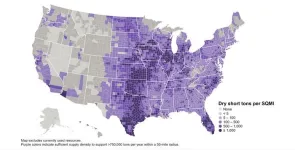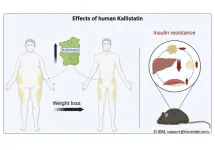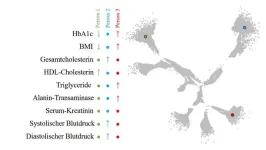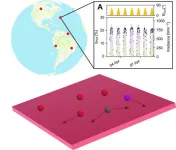(Press-News.org) The United States could triple its current bioeconomy by producing more than 1 billion tons per year of plant-based biomass for renewable fuels, while meeting projected demands for food, feed, fiber, conventional forest products and exports, according to the Department of Energy’s latest Billion-Ton Report led by Oak Ridge National Laboratory.
The 2023 Billion-Ton Report, or BT23, announced by DOE, is the fourth in a series of national biomass resource assessments spanning two decades. The report identifies feedstocks that could be available to produce biofuels to decarbonize transportation and industrial processes.
The report examines different levels of market maturity to assess the quantity of biomass that could be produced, its price, geographical density and distribution. The report covers biomass production capacity from some 60 resources, including winter oilseed crops, trees and brush harvested to prevent forest wildfires, purpose-grown energy crops, macroalgae such as seaweed cultivated in ocean farms, waste captured from cities and carbon dioxide from industrial plants. Harnessing emerging resources, such as algae, could boost biomass availability by another 250 million tons per year, depending on price, the report found.
The United States currently uses about 342 million tons per year of biomass to generate 5% of the nation’s energy. In a mature market where between 1.1 and 1.5 billion tons per year of biomass is available, the nation could produce 60 to 85 billion gallons per year of sustainable aviation fuel, reaching the goal of meeting 100% of the sector’s demand by 2050. Another use would be producing enough electricity to replace the power currently generated with fossil fuels.
No single source of biomass can supply all that’s needed, and the report identifies opportunities for biomass production down to the county level based on local conditions and evolving technologies. These resources and easy-to-use tools are available on DOE’s Bioenergy Knowledge Discovery Framework website.
“An economy based on clean, sustainable biotechnologies and biomanufacturing is within reach,” said ORNL Director Stephen Streiffer. “The latest Billion-Ton report provides invaluable information to develop science-based solutions for a greener, more prosperous future. ORNL is excited to be part of that.”
“The report describes biomass production capacity in response to different market demand and pricing scenarios. The results show resources that would be accessible within economic and environmental constraints, including protecting food production,” said Matthew Langholtz, natural resources economist at ORNL and the project lead. “Even with these constraints, in a mature market with sufficient supply and demand, we could produce 1.5 billion tons of biomass annually, and even more with the new resources we identify.”
Farmers and bioeconomy stakeholders can use the report as a first step to identify biomass production opportunities. Hardy perennial crops such as poplar trees and switchgrass that need less water and fertilizer, and winter oilseed crops like carinata and pennycress can provide additional farm income. Cities could capture waste discarded in landfills, supporting a circular economy.
The report follows the 2005 U.S. Billion-Ton Study, the 2011 U.S. Billion-Ton Update and the 2016 U.S. Billion-Ton Report, all managed by ORNL researchers. The new assessment includes contributions and reviews by 52 experts from 11 federal agencies, national laboratories, universities and industry.
“Data behind the new Billion-Ton Report — as well as data from past reports — can be used to drive local, regional and national decision-making,” said Maggie Davis, natural resources data scientist at ORNL. “We leveraged modern data methods to make accessing and using the data easy for government decision-makers, industry leaders, farmers, researchers and other stakeholders who support the bioeconomy. The information can also be used to chart a course for larger investments in support of strategically targeted scientific research.”
The 2023 report “is the culmination of 20 years of meticulous analysis taking into account the potential from croplands, forests and new sources of biomass along with economic and environmental considerations, transportation and logistics and evolving technologies. We identify pathways to boost both rural and urban bioeconomies in support of a cleaner future,” said Erin Webb, lead for the Bioresource Science and Engineering group and relationship manager for DOE’s Bioenergy Technologies Office at ORNL.
ORNL’s biomass resource expertise, including Billion-Ton data and analysis, also supported the Roads To Removal national report released in December 2023 that identified 1 billion metric tons of carbon dioxide removal potential in the United States, charting a path toward the goal of a net-zero emissions economy by 2050.
UT-Battelle manages ORNL for the Department of Energy’s Office of Science, the single largest supporter of basic research in the physical sciences in the United States. The Office of Science is working to address some of the most pressing challenges of our time. For more information, please visit energy.gov/science.
The United States could triple its current bioeconomy by producing more than 1 billion tons per year of plant-based biomass for renewable fuels, while meeting projected demands for food, feed, fiber, conventional forest products and exports, according to the Department of Energy’s latest Billion-Ton Report led by Oak Ridge National Laboratory.
The 2023 Billion-Ton Report, or BT23, announced by DOE today, is the fourth in a series of national biomass resource assessments spanning two decades. The report identifies feedstocks that could be available to produce biofuels to decarbonize transportation and industrial processes.
The report examines different levels of market maturity to assess the quantity of biomass that could be produced, its price, geographical density and distribution. The report covers biomass production capacity from some 60 resources, including winter oilseed crops, trees and brush harvested to prevent forest wildfires, purpose-grown energy crops, macroalgae such as seaweed cultivated in ocean farms, waste captured from cities and carbon dioxide from industrial plants. Harnessing emerging resources, such as algae, could boost biomass availability by another 250 million tons per year, depending on price, the report found.
The United States currently uses about 342 million tons per year of biomass to generate 5% of the nation’s energy. In a mature market where between 1.1 and 1.5 billion tons per year of biomass is available, the nation could produce 60 to 85 billion gallons per year of sustainable aviation fuel, reaching the goal of meeting 100% of the sector’s demand by 2050. Another use would be producing enough electricity to replace the power currently generated with fossil fuels.
No single source of biomass can supply all that’s needed, and the report identifies opportunities for biomass production down to the county level based on local conditions and evolving technologies. These resources and easy-to-use tools are available on DOE’s Bioenergy Knowledge Discovery Framework website.
“An economy based on clean, sustainable biotechnologies and biomanufacturing is within reach,” said ORNL Director Stephen Streiffer. “The latest Billion-Ton report provides invaluable information to develop science-based solutions for a greener, more prosperous future. ORNL is excited to be part of that.”
“The report describes biomass production capacity in response to different market demand and pricing scenarios. The results show resources that would be accessible within economic and environmental constraints, including protecting food production,” said Matthew Langholtz, natural resources economist at ORNL and the project lead. “Even with these constraints, in a mature market with sufficient supply and demand, we could produce 1.5 billion tons of biomass annually, and even more with the new resources we identify.”
Farmers and bioeconomy stakeholders can use the report as a first step to identify biomass production opportunities. Hardy perennial crops such as poplar trees and switchgrass that need less water and fertilizer, and winter oilseed crops like carinata and pennycress can provide additional farm income. Cities could capture waste discarded in landfills, supporting a circular economy.
The report follows the 2005 U.S. Billion-Ton Study, the 2011 U.S. Billion-Ton Update and the 2016 U.S. Billion-Ton Report, all managed by ORNL researchers. The new assessment includes contributions and reviews by 52 experts from 11 federal agencies, national laboratories, universities and industry.
“Data behind the new Billion-Ton Report — as well as data from past reports — can be used to drive local, regional and national decision-making,” said Maggie Davis, natural resources data scientist at ORNL. “We leveraged modern data methods to make accessing and using the data easy for government decision-makers, industry leaders, farmers, researchers and other stakeholders who support the bioeconomy. The information can also be used to chart a course for larger investments in support of strategically targeted scientific research.”
The 2023 report “is the culmination of 20 years of meticulous analysis taking into account the potential from croplands, forests and new sources of biomass along with economic and environmental considerations, transportation and logistics and evolving technologies. We identify pathways to boost both rural and urban bioeconomies in support of a cleaner future,” said Erin Webb, lead for the Bioresource Science and Engineering group and relationship manager for DOE’s Bioenergy Technologies Office at ORNL.
ORNL’s biomass resource expertise, including Billion-Ton data and analysis, also supported the Roads To Removal national report released in December 2023 that identified 1 billion metric tons of carbon dioxide removal potential in the United States, charting a path toward the goal of a net-zero emissions economy by 2050.
UT-Battelle manages ORNL for the Department of Energy’s Office of Science, the single largest supporter of basic research in the physical sciences in the United States. The Office of Science is working to address some of the most pressing challenges of our time. For more information, please visit energy.gov/science.
END
Sustainable biomass production capacity could triple US bioeconomy, report finds
2024-03-18
ELSE PRESS RELEASES FROM THIS DATE:
Cure Mito Foundation and Hope for PDCD Foundation announce a patient registry collaboration
2024-03-18
March 18, 2024 – Cure Mito Foundation and Hope for PDCD foundation, both patient-led foundations focused on advancing research and supporting families affected by Leigh syndrome and Pyruvate Dehydrogenase Complex Deficiency (PDCD), respectively, are excited to announce a launch of a PDCD patient registry. This innovative registry will be led by the Hope for PDCD foundation and hosted on the same registry platform as the well-established Leigh Syndrome patient registry, developed by the Cure Mito Foundation. This strategic move is aimed at enhancing patient convenience and improving data alignment and research ...
Newborn piglets serve as a model for studying influenza
2024-03-18
Although prevention and treatment strategies are available for influenza, they are not sufficient for vulnerable populations such as young children and newborns. In a new study, published in Virology, a multidisciplinary team of researchers have studied newborn piglets to better understand the progression of influenza infections.
The influenza A virus can infect a variety of birds and mammals, including humans and pigs, due to which it is a threat to public health and food security. While it causes mild ...
Kallistatin contributes to the beneficial metabolic effects of weight loss
2024-03-18
After weight loss, people with overweight and obesity express more of the protein Kallistatin* in subcutaneous white adipose tissue. This was demonstrated by researchers from the DZD in a recent study. In addition, Kallistatin improves metabolism and could open up new therapeutic options for people with obesity and type 2 diabetes in future. The results have now been published in Molecular Metabolism.
An increasing number of people are developing type 2 diabetes and obesity. These are highly complex and multifaceted diseases. In order to treat them sustainably, new approaches to therapy are needed. Clinical studies on humans have ...
WashU engineers manage a first: measuring pH in cell condensates
2024-03-18
Scientists trying to understand the physical and chemical properties that govern biomolecular condensates now have a crucial way to measure pH and other emergent properties of these enigmatic, albeit important cellular compartments.
Condensates are communities of proteins and nucleic acids. They lack a membrane and come together and fall apart as needed. The nucleolus is a prominent condensate in cells. It serves vital roles in cellular physiology and is the site of ribosome production.
Ribosomes are the multi-protein ...
Study with innovative insights into the heterogeneity of type 2 diabetes
2024-03-18
A landmark study by the German Diabetes Center (DDZ), published in The Lancet Diabetes & Endocrinology, sheds new light on the heterogeneity of type 2 diabetes. The researchers employed an innovative algorithm to stratify people with type 2 diabetes using routine data and thus visualize the metabolic diversity of diabetes.
Type 2 diabetes is a disease with highly diverse progression pathways. Using an innovative algorithm, a team led by the German Diabetes Center (DDZ) used routinely measured variables to open up new perspectives on the diversity of type 2 diabetes in terms of insulin sensitivity, insulin secretion, ...
Breakthrough in melting point prediction: over 100-year-old physics problem solved by Queen Mary Professor
2024-03-18
A longstanding problem in physics has finally been cracked by Professor Kostya Trachenko of Queen Mary University of London's School of Physical and Chemical Sciences. His research, published in the Physical Review E, unveils a general theory for predicting melting points, a fundamental property whose understanding has baffled scientists for over a century.
For decades, our understanding of the three basic states of matter – solids, liquids, and gases – relied on temperature-pressure phase diagrams. These diagrams depict the conditions under which each state exists, with distinct lines separating them. However, one crucial line, ...
Shining a light on the underpinnings of rare disease impacting children
2024-03-18
A team from the University of Ottawa's Faculty of Medicine has completed an exciting new study that reveals the inner workings of gene mutations that result in an ultra-rare syndrome with fewer than 100 reported cases since its first description in the early 1960s.
The hard-won research discovery may accelerate the development of a treatment for Borjeson-Forssman-Lehmann Syndrome (BFLS), a neurodevelopmental disorder linked to the X chromosome that’s characterized by seizures, intellectual disability, and behavioural ...
Landmark study shows that ‘transcendent’ thinking may grow teens’ brains over time
2024-03-18
Scientists at the USC Rossier School of Education’s Center for Affective Neuroscience, Development, Learning and Education (CANDLE), have shown for the first time that a type of thinking, that has been described for over a century as a developmental milestone of adolescence, may grow teenagers’ brains over time. This kind of thinking, which the study’s authors call “transcendent,” moves beyond reacting to the concrete specifics of social situations to also consider ...
Reimagining the future of solar energy
2024-03-18
Scientists are always on the lookout for ways to make our world a better place, and one area they're focusing on is solar energy. One idea in this area is to make solar cells more efficient by concentrating more solar light onto them. While investigating this recently, a group of scientists at the Cavendish Laboratory and AMOLF (Amsterdam NL) have found that improving solar cells efficiency in this way is harder than we might think but have discovered other avenues by which it might be possible to improve solar energy capture anywhere on the planet.
The researchers ...
Metformin during pregnancy impacts offspring brain development
2024-03-18
With the rise in gestational diabetes and metabolic disorders during pregnancy, metformin is also being prescribed more frequently. Although it is known that the oral antidiabetic agent can cross the placental barrier, the impacts on the brain development of the child are largely unknown. An interdisciplinary research team from the German Institute of Human Nutrition Potsdam-Rehbrücke (DIfE) have now been able to demonstrate in a mouse model that although metformin has positive effects in pregnant animals, it does not in the offspring. The results were published in the specialist ...







